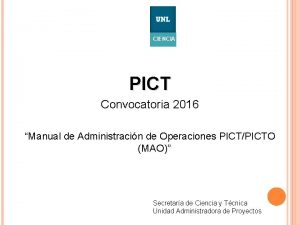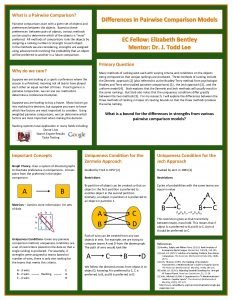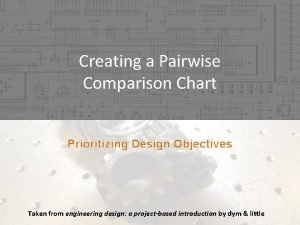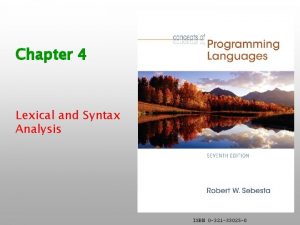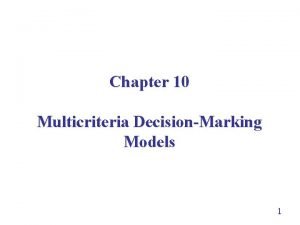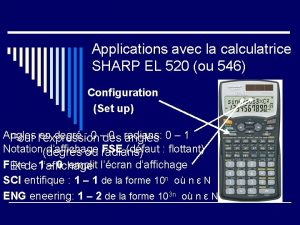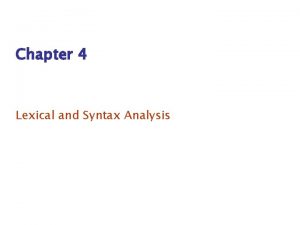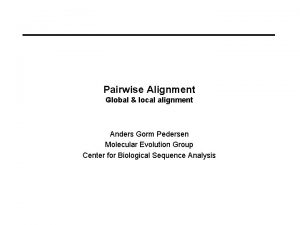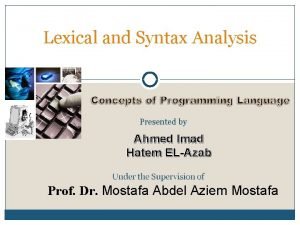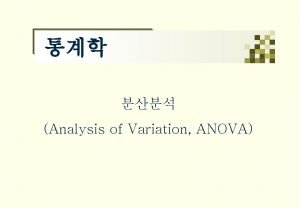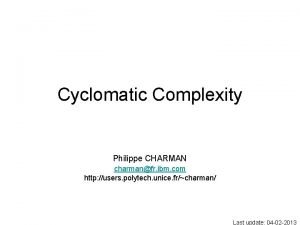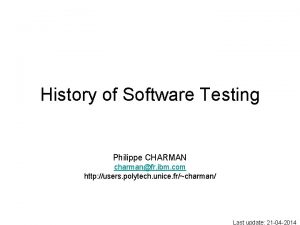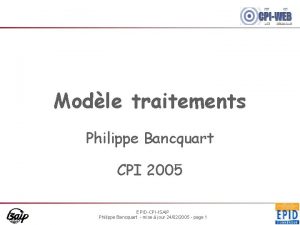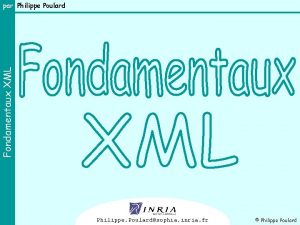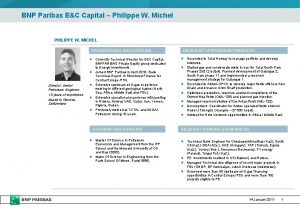Exercise Using The Pairwise Tool PICT Philippe CHARMAN




![Model files • A model is composed of 3 sections: parameter definitions [sub-model definitions] Model files • A model is composed of 3 sections: parameter definitions [sub-model definitions]](https://slidetodoc.com/presentation_image/445f5e01f5b2b6d1779f5807a83342c2/image-5.jpg)



![Conditional constraints • A term [parameter] relation value is an atomic part of a Conditional constraints • A term [parameter] relation value is an atomic part of a](https://slidetodoc.com/presentation_image/445f5e01f5b2b6d1779f5807a83342c2/image-9.jpg)



















- Slides: 28

Exercise: Using The Pairwise Tool PICT Philippe CHARMAN charman@fr. ibm. com http: //users. polytech. unice. fr/~charman/ Last update: 10 April 2015

Preliminary • Suppose a function f takes five Boolean variables as arguments: x 1, x 2, x 3, x 4 and x 5. • Boolean values are expressed as 0 and 1 for simplicity reason • Design the smallest test suite that meets the pairwise property x 1 x 2 x 3 x 4 x 5 0 0 0 ? ? ?

Overview PICT • PICT is a pairwise testing tool developed by Microsoft • PICT is the acronym of Pairwise Independent Combinatorial Testing • Used to design test cases and test configurations for software systems • PICT generates a compact set of parameter value choices that represent the test cases you should use to get comprehensive combinatorial coverage of your parameters.

Installing PICT • Install PICT from pict 33. msi • Update the environment variable PATH • Help in PICTHelp. htm
![Model files A model is composed of 3 sections parameter definitions submodel definitions Model files • A model is composed of 3 sections: parameter definitions [sub-model definitions]](https://slidetodoc.com/presentation_image/445f5e01f5b2b6d1779f5807a83342c2/image-5.jpg)
Model files • A model is composed of 3 sections: parameter definitions [sub-model definitions] [constraint definitions] • Model sections should always be specified in the order shown above and cannot overlap • The sub-model and the constraint sections are optional • Sections do not require any special separators between them • Empty lines can appear anywhere • Comments can be included by prefixing lines with the “#”character.

Simple Model • Syntax of the parameter definitions <Param. Name> : <Value 1>, <Value 2>, <Value 3>, . . . • Sample model for testing volume create/delete functions Type: Primary, Logical, Single, Span Size: 10, 100, 500, 1000, 5000, 10000 Format method: quick, slow File system: FAT, FAT 32, NTFS Cluster size: 512, 1024, 2048, 4096, 8192, 16384 Compression: on, off

Generating Test Cases • Given this model C: >more mymodel. txt X: 1, 2 Y: A, B, C Z: 1, 2, by default pairwise test cases are generated: C: >pict mymodel. txt X Y Z 2 B 2 1 A 1 2 C 1 2 A 2 1 B 1 1 C 2

Configuration test cases • Suppose we want to test on different platforms: C: >more conf. txt OS: x 86, x 64 Win: Win 7, Win 8 C++: msvc 10, msvc 11 Java: JDK 6, JDK 7 by default: C: >pict conf. txt OS Win C++ Java x 64 Win 7 msvc 10 JDK 6 x 64 Win 8 msvc 11 JDK 7 x 86 Win 8 msvc 10 JDK 7 x 86 Win 7 msvc 11 JDK 7 x 86 Win 8 msvc 11 JDK 6
![Conditional constraints A term parameter relation value is an atomic part of a Conditional constraints • A term [parameter] relation value is an atomic part of a](https://slidetodoc.com/presentation_image/445f5e01f5b2b6d1779f5807a83342c2/image-9.jpg)
Conditional constraints • A term [parameter] relation value is an atomic part of a predicate. The following relations can be used: =, <>, >, >=, <, <=, and LIKE is a wildcard-matching operator (* - any character, ? – one character). [Size] < 10000 [Compression] = "OFF" [File system] like "FAT*" • Operator IN allows specifying a set of values that satisfy the relation explicitly: IF [Cluster size] in {512, 1024, 2048} THEN [Compression] = "Off"; IF [File system] in {"FAT", "FAT 32"} THEN [Compression] = "Off";

Conditional constraints • Parameters can be compared to other parameters, as in this example: # Machine 1 OS_1: Win 2000, Win. XP SKU_1: Professional, Server, Datacenter, Win. Powered LANG_1: EN, DE # Machine 2 OS_2: Win 2000, Win. XP SKU_2: Professional, Server, Datecenter LANG_2: EN, DE IF [LANG_1] = [LANG_2] THEN [OS_1] <> [OS_2] AND [SKU_1] <> [SKU_2];

Unconditional constraints (Invariants) • An invariant declares an always-valid limitation of a domain: # At least one parameter must be different to be a meaningful test case (use the OR operator) [OS_1] <> [OS_2] or [SKU_1] <> [SKU_2] or [LANG_1] <> [LANG_2]; # All parameters must different (use the AND operator) [OS_1] <> [OS_2] and [SKU_1] <> [SKU_2] and [LANG_1] <> [LANG_2];

Parameter Types • PICT uses the concept of parameter types. There are two types of parameters: string and numeric. A parameter is considered numeric only when all its values are numeric. If a value has multiple names, only the first one counts. Types are only important when evaluating constraints. You can only compare a numeric parameter to a number, and a string parameter to another string. For example: Size: 1, 2, 3, 4, 5 Value: a, b, c, d IF [Size] > 3 THEN [Value] > "b"; • String comparison is lexicographical and case-insensitive by default. You can make comparisons case-sensitive if you specify the /c option. Numeric values are compared as numbers.

Exercise • An application is available in 32 -bit and 64 -bit and can be used on the following platforms: – – Windows 7 – x 86 and x 64 Windows 8 – x 86 and x 64 AIX 6. 1 - Power 7 32 -bit and 64 -bit AIX 7. 1 – Power 7 32 -bit and 64 -bit • The following locales are supported: EN, CN, JP, DE, FR • The following databases are supported: Oracle 9 i, Oracle 10 g, Oracle 11 g, DB 2 9. 1, DB 2 9. 7

Writing the model • Write a model to generate pairwise test cases • Trivial constraints: – The 32 -bit application should be tested on the 32 -bit and 64 -bit architectures. – The 64 -bit application cannot be tested on a 32 -bit architecture • About 27 test cases should be generated

Configuration test cases • In the solution proposed: OS Win C++ Java x 64 Win 7 msvc 10 JDK 6 x 64 Win 8 msvc 11 JDK 7 x 86 Win 8 msvc 10 JDK 7 x 86 Win 7 msvc 11 JDK 7 x 86 Win 8 msvc 11 JDK 6 • No tests are done on x 64/Win 7 to test msvc 11 or x 64/Win 8 to test msvc 10 • Testing the pair (OS, Win) is more important than testing the pair (C++, Java)

Sub Models • Syntax of the sub-model definitions: {<Param. Name 1>, <Param. Name 2>, . . . } @ <Order> • Example: PLATFORM: x 86, ia 64, amd 64 CPUS: Single, Dual, Quad RAM: 128 MB, 1 GB, 4 GB, 64 GB HDD: SCSI, IDE OS: NT 4, Win 2 K, Win. XP, Win 2 K 3 IE: 4. 0, 5. 5, 6. 0 APP: SQLServer, Exchange, Office { PLATFORM, CPUS, RAM, HDD } @ 3 { OS, IE } @ 2

Sub Models • Syntax of the sub-model definitions: {<Param. Name 1>, <Param. Name 2>, . . . } @ <Order> • Example: PLATFORM: x 86, ia 64, amd 64 CPUS: Single, Dual, Quad RAM: 128 MB, 1 GB, 4 GB, 64 GB HDD: SCSI, IDE OS: NT 4, Win 2 K, Win. XP, Win 2 K 3 IE: 4. 0, 5. 5, 6. 0 APP: SQLServer, Exchange, Office { PLATFORM, CPUS, RAM, HDD } @ 3 { OS, IE } @ 2

How the generation would look for the previous model $ | order = 2 (defined by /o) | +---------------+---------------+ | order = 3 | order = 2 | { PLATFORM, CPUS, RAM, HDD } { OS, IE } APP

Sub Models • You can define as many sub-models as you want; any parameter can belong to any number of sub-models. Model hierarchy can be just one level deep • The combinatory order of a sub-model cannot exceed the number of its parameters. In the example above, an order of the first sub-model can be any value between one and four • If you do not specify the order for a sub-model, PICT uses the default order or the order specified by /o option

Sub Models C: > more conf. txt OS: x 86, x 64 Win: Win 7, Win 8 C++: msvc 10, msvc 11 Java: JDK 6, JDK 7 {OS, Win} @ 2 C: >pict conf. txt OS Win C++ Java x 86 Win 8 msvc 10 JDK 7 x 86 Win 7 msvc 11 JDK 7 x 86 Win 7 msvc 10 JDK 6 x 64 Win 7 msvc 11 JDK 7 x 86 Win 8 msvc 11 JDK 6 x 64 Win 7 msvc 10 JDK 6 x 64 Win 8 msvc 11 JDK 7

Sub Models C: > more conf 2. txt x: 0, 1 y: 2, 3 z: 4, 5 t: 6, 7 {x, y} @ 2 {z, t} @ 2 x, y: S 1 = {(0, 2), (0, 3), (1, 2), (1, 3)} z, t: S 2 = {(4, 6), (4, 7), (5, 6), (5, 7)} The solution for this model is the Cartesian product S 1 x. S 2

Sub Models C: >pict conf 2. txt x y z t 1 2 5 7 0 2 4 6 0 2 5 7 0 2 4 7 0 3 5 6 1 2 4 7 0 3 4 6 0 3 5 7 0 2 5 6 1 3 5 7 1 3 4 7 1 2 5 6 1 3 5 6 1 2 4 6 1 3 4 6 0 3 4 7

Defining a sub-model • In the model, express the pair (Application, Architecture, OS) as a sub-model • How many test cases are now generated ?

Trying to reduce the test case • Still too many test cases • Among the locales, we need to test EN above all. Other locales should be tested only once on only platform • Among the databases, we need to test DB 2 9. 7 above all. Other databases should be tested only once on any platform • Is it possible to express these constraints in PICT ?

Randomized generation • C: more try. txt x: 0, 1 y: 0, 1 z: a, b t: a, b {z, t} @1

Randomized generation C: >pict try 1. txt /r: 1 Used seed: 1 x y z t 1 0 a b 0 1 b a 1 1 b a 0 0 b a 0 1 a b C: >pict try 1. txt /r: 1000 Used seed: 1000 x y z t 0 1 b b 1 0 b b 0 0 a a 1 1 a a

Generating Test Cases • N-wise test cases can be generated with /o: N C: >pict mymodel. txt /o: 3 X Y Z 1 B 1 2 B 2 1 C 2 1 B 2 2 C 2 2 B 1 2 A 1 1 A 2 1 C 1 2 A 2 2 C 1

Further reading • More information on PICT: http: //msdn. microsoft. com/en-us/library/cc 150619. aspx • Many resources on pairwise testing: http: //www. pairwise. org/ The site is maintained by Jacek Czerwonka who developed PICT
 Pict tool
Pict tool Yandex pict
Yandex pict Manual de administración de operaciones de pict 2020
Manual de administración de operaciones de pict 2020 Pairwise comparison
Pairwise comparison Pairwise independent
Pairwise independent Graph based method layout
Graph based method layout Comparison chart design
Comparison chart design Independent event formula
Independent event formula Pairwise correlation
Pairwise correlation Pairwise disjoint test
Pairwise disjoint test Pairwise comparison matrix
Pairwise comparison matrix Sharp el-520
Sharp el-520 What is a disjoint event
What is a disjoint event Pairwise key
Pairwise key Pairwise disjointness test example
Pairwise disjointness test example Blast vs fasta
Blast vs fasta Ebi pairwise alignment
Ebi pairwise alignment Pairwise alignment
Pairwise alignment Pairwise alignment
Pairwise alignment Pairwise alignment
Pairwise alignment Listwise vs pairwise
Listwise vs pairwise Pairwise disjointness test
Pairwise disjointness test Tukey pairwise comparison minitab
Tukey pairwise comparison minitab Pairwise.org
Pairwise.org Pairwise comparison anova
Pairwise comparison anova Potter's wheel data cleaning tool
Potter's wheel data cleaning tool Hình ảnh bộ gõ cơ thể búng tay
Hình ảnh bộ gõ cơ thể búng tay Slidetodoc
Slidetodoc Bổ thể
Bổ thể


